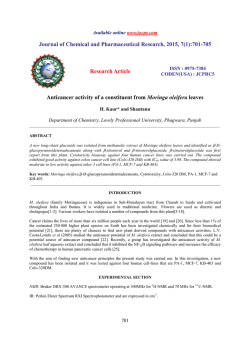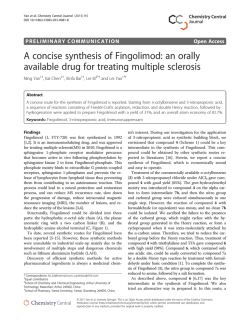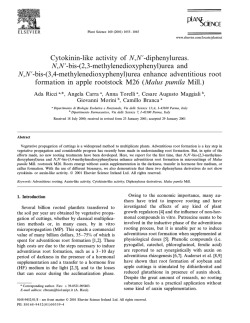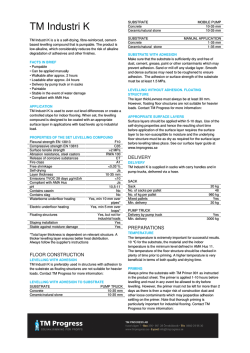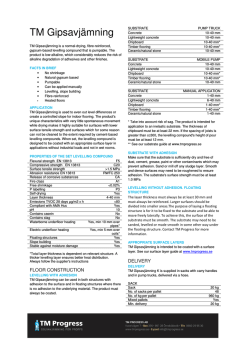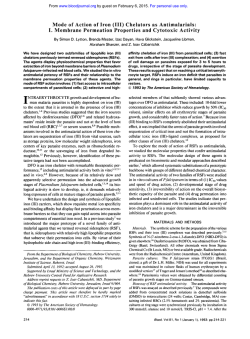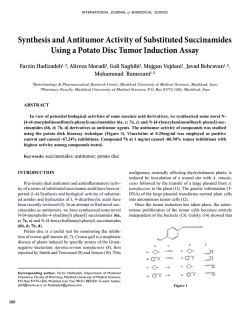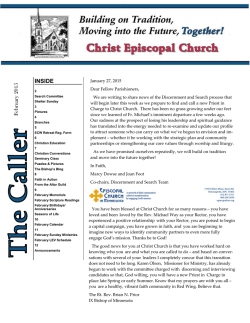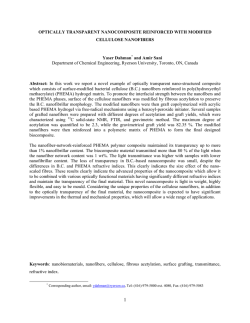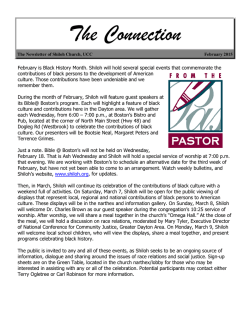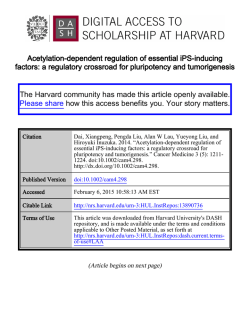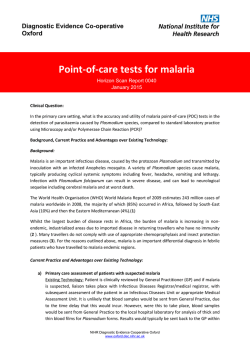
Synthesis pterocarpancompounds from Erythrina crista
Available online www.jocpr.com Journal of Chemical and Pharmaceutical Research, 2015, 7(1):666-670 Research Article ISSN : 0975-7384 CODEN(USA) : JCPRC5 Synthesis pterocarpan compounds from Erythrina crista-galli L and their action towards Plasmodium falciparum Tjitjik Sri Tjahjandarie*, Ratih Dewi Saputri and Mulyadi Tanjung Natural Products Chemistry Research Group, Organic Chemistry Division, Department of Chemistry, Faculty of Science and Technology, Universitas Airlangga, Surabaya, Indonesia _____________________________________________________________________________________________ ABSTRACT Synthesis of the naturally occurred 3-acetyl sandwicensin(2) and 2,7- dibromosandwicensin(3)was carried out by acetylation and bromination reaction, respectively. The pterocarpan synthesized in this study was andwicensin(1) isolated from stem bark of Erythrina crista galli L. Their structures were established on the basis of spectroscopic evidence. Compounds 1–3 were evaluated for their antimalarial properties against Plasmodium palcifarum, showing their IC50 were 1.83, 34.81 and 12.9 µg/mL, respectively. Keywords: 3-acetyl sandwicensin, 2,7-dibromosandwicensin, acetylation reaction, bromination reaction, antimalarial activity. _____________________________________________________________________________________________ INTRODUCTION Malaria remains world one of the most devastating human parasitic infection affecting more than 500 million people and causing about 1-3 million deaths each year [1]. Plasmodium is transmitted by anopheline mosquitoues and undergoes a complex sexual developmental cycle in the insect host. Recently, chloroquine and artemisinin have used as antimalarial drug and show resistance against Plasmodium parasites in Indonesia. Erythrina belongs to the family of Leguminosae and Erythrina crista galli L is one species of Erythrina. This plant has been shown to produce a number of pterocarpan and alkaloid compounds that showed activity as anticancer, antioxidant, and antimalarial. Sandwicensin is a mayor compound which has been isolated from Erythrina crista galliand its activity as antimalarial [2]. In continuation of these chemical investigations, we will continue research to synthesize mayor compounds that is sandwicensin with acetylation and bromination method. This paper discusses the structure elucidation of the two compounds synthesized from the reaction of acetylation and bromination and their antimalarial activity. EXPERIMENTAL SECTION Synthesis of pterocarpan derived from sandwicensin compounds produced from stem bark of Erythrina crista galli was carried out by acetylation and bromination reaction, respectively. In the acetylation synthetic route, 3 mg sandwicensin compound is added to 0.2 ml of pyridine with the addition of 0.2 ml of anhydride acetate. It was cooled to room temperature and poured over crushed ice. The separated solid was filtered, washed with distilled water, dried and it was crystallized with ether-methanol to form a 3-acetyl sandwicensin [3]. Bromination synthetic route, in the fume hood, 0.1 g or 0.2 ml of sandwicensin compound is added to 2 ml of carbon tetrachloride and 5% 666 Tjitjik Sri Tjahjandarie et al J. Chem. Pharm. Res., 2015, 7(1):666-670 ______________________________________________________________________________ solution of bromine in carbon tetrachloride is added drop wise, with shaking, and reflux for 5h until the bromine color persist and to form 2,7- dibromosandwicensin [4]. 4 HO 4a 6 11b 6a 1 H 4 AcO O O 4a 6 11b 6a H 1 11a 6b 10a O (i) 9 OCH3 H 11a 6b 10a H 9 O OCH3 (ii) 2, 2, 4, 4, 5, 5, Figure-1.Preparation of compound 3-acetyl sandwicensin (2),colorless solid :(i) pyridine,anhydride acetate,temperature 37oC; (ii) crystallized eter-metanol 4 HO 1 H 4 HO O 4a 6 11b 6a O 4a 6 11b 6a H Br 11a 6b 10a 9 O OCH3 1 H (i) H Br 11a 6b 10a 9 O OCH3 (ii) 2, 2, 4, 4, 5, Sandwicensin 5, 2,7-Dibromo sandwicensin Figure-2. Preparation of compound 2,7-dibromo sandwicensin (3), yellow solid: (i) CCl4, 5% Br2 in CCl4; (ii) reflux 5h, bromine color persist Sandwicensin(1), yellow solid,1H NMR (500 MHz, CDCl3) data, see Table-1; UV (MeOH) λmax nm (log ɛ) : 223 (4.60), 285 (3.84), and 287 nm (3.89).HR-ESI-mass spectra (m/z 339.1642 [M+H]+, calcd. for C21H23O4, 325.1440). 3-Acetyl sandwicensin(2), colourless solid, 1H-NMR (500 MHz,CDCl3) data, see Table-1;UV (MeOH) λmax nm (log ɛ) : 285 (3.90), and 289 nm (4,10). 2,7-Dibromo sandwicensin(3) ,yellow solid,1H-NMR (500 MHz, CDCl3) data, see Table-1;UV (MeOH) λmax nm (log ɛ) : 229 (4.13), 286 (3.84), and 289 nm (3.86). Antimalarial properties ofcompound1-3 against Plasmodium palcifarum were obtained from the Institute of Tropical Diseases, Universitas Airlangga, Surabaya, Indonesia. In vitro antimalarial activity against Plasmodium palcifarum was carried out according to a modified method of Trager and Jensen using RPMI 1640medium with10% O+ serum [5]. The antimalarial activity of three phenolic compounds and chloroquine (positive control) were measured in triplicate. Fresh red blood cells were used as a negative control. The active compound was dissolved in DMSO and diluted with RPMI 1640 medium to prepare a series of concentration. Parasitaemia was evaluated after 48 by Giemsa stain and the average percentage suppression of parasitaemia was calculated by following equation [6,7]: % = 100 × % % − % The influence of the active compound on the growth of parasites were expressed by the 50% inhibitory concentrations (IC50) which were determined using linier regression analysis. 667 Tjitjik Sri Tjahjandarie et al J. Chem. Pharm. Res., 2015, 7(1):666-670 ______________________________________________________________________________ RESULTS AND DISCUSSION Sandwicensin is a mayor compound produced from stem bark Erythrina crista galli L [8]. Sandwicensin (1)was isolated as a yellow solid, and its UV spectrum exhibited absorption maxima λmaks(nm) (log ε): 223 (4.60), 285 (3.84), and287 nm (3.89) a typical for a pterocarpan. From HR-ESI-mass spectra (m/z 339.1642 [M+H]+, calcd. for C21H23O4, 325.1440).The 1H and 13C NMR can be seen in Table 1. There is one methoxyl groups attached to the aromatic ring from compound 1 that showed proton signal at δH3.81 and the carbon signal at 55.9.The placement of a methoxy group in the C-3or C-9 confirmed by the HMQC and HMBC spectra. The HMBC spectrum shows a correlation between the proton signal at δH3.81with carbonoxyaril signal at δC 155.8. Furthermore, the correlation between aromatic proton signals at δH7.02 (d, 8.1, H-7)with oxyaril carbon signal at δC 155.8 indicated that the methoxyl group attached at C-9. O HO H H O OCH3 Figure 3.The significant HMBC correlations of 1 3-Acetyl sandwicensin(2) produced from synthesis sandwicensin (1) using acetylation methods. 3-Acetyl sandwicensin obtained as colourless solid, its UV spectrum exhibited absorption maxima λmaks(nm) (log ε): 223 (4.60), 285 (3.84), and287 nm (3.89). Based on 1H-NMR proton spectrum showed four proton signal atδH 5.46 (1H, d, J = 6.7 Hz); 4.25 (1H, t, J = 10.8 Hz; 3.64 (1H, dd, J = 10.8 Hz); and 3.54 (1H, m)which is typical for pterocarpan structure.1H-NMR spectrum of compound 1 shows two signals of aromatic unit, there are a pair of doublet signals ortho (J = 8.1 Hz) atδH7.01 dan 6.40 and the presence of three other aromatic proton signals with ABX system atδH7.54 (1H, d, J = 8.4 Hz); 6.78 (1H, dd, J = 8.4 and 2.4 Hz); and6.68 ppm (1H, d, J = 2.4 Hz). The presence of the methyl group δH1.56 at C-3 shows that acetyl bond to sandwicensin skeleton and compound 2 was identified 3-acetyl sandwicensin. 2,7-Dibromo sandwicensin(3) produced from synthesis sandwicensin (1)using bromination methods. 2,7-Dibromo sandwicensin isolated as yellow solid, its UV spectrum exhibited absorption maxima λmaks(nm) (log ε): 229 (4.13), 286 (3.84), and 289 nm (3.86). Based on 1H-NMR spectral data of compounds 3 shows similar pattern of the 1H and 13 C chemical shifts of NMR with compound 2. The difference with compound 3 is the addition of two bromide groups. Two proton singlets at δH7.59(1H, H-1) and 6.25 (1H, H-4) showed the presence of four substituents attached to the ring A and also shows that the presence of bromide group attached to the C-2. The presence of one proton singlets δH7.31 at H-8 and methoxy group at C-9 showed that the bromide group in the position at C-7. Based on 1D NMR data, compound 3 was identified 2,7-dibromo sandwicensin. 668 Tjitjik Sri Tjahjandarie et al J. Chem. Pharm. Res., 2015, 7(1):666-670 ______________________________________________________________________________ AcO 4 O 4a 6 11b 6a 1 H HO 4 O 4a 6 11b 6a H Br 11a 6b 10a 9 O 1 H OCH3 H Br 11a 6b 10a 9 O OCH3 2, 2, 4, 4, 5, 5, 2,7-dibromo sandwicensin 3-acetyl sandwicensin Figure 4.Synthesis of pterocarpan derived from sandwicensin Table 1. NMR spectroscopic data of sandwicensin(1), 3-acetyl sandwicensin (2), and 2,7-dibromo sandwicensin(3) in CDCl3 No.H 1 2 3 4 4a 6 6a 6b 7 8 9 10 10a 11a 11b 1’ 2’ 3’ 4’ 5’ 9-OCH3 3-CH3 δH (mult, J Hz) Sandwicensin (1) 7.41 (d, 8.4) 6.58 (dd, 8.4; 2.4) 6.44 (d, 2.4) 4.23 (t, 10.9); 3.66 (dd,10.9; 5.1) 3.52 (m) 7.02 (d, 8.1) 6.42 (d,8.1) 5.46 (d, 6.8) 3.31 (d, 7.9) 5.26 (t, 7.2) 1.78 (s) 1.67 (s) 3.81 (s) - δH (mult, J Hz) 3-Acetyl sandwicensin (2) 7.54 (d, 8.4) 6.78 (dd, 8.4; 2.4) 6.68 (d, 2.4) 4.25 (t, 10.8); 3.64 (dd,10.8) 3.54 (m) 7.01 (d, 8.1) 6.40 (d,8.1) 5.46 (d, 6.7) 3.26 (d, 6.4) 5.21 (t, 8.3) 1.74 (s) 1.64 (s) 3.78 (s) 1.56 (s) δH (mult, J Hz) 2,7-Dibromo sandwicensin (3) 7.59 (s) 6.05 (s) 4.48 (dd;8); 3.26 (dd,8) 3.53 (m) 7.31 (s) 5.48(d; 7.4) 3.31 (d;8.6) 5.54 (d;6.9) 1.57 (s) 1.41 (s) 3.83 (s) - Compound 1 isolated from the stem bark of E.crista-galli and synthesis compound 2-3 was assessed for their antimalarial activity against Plasmodium falciparum. The results are presented in Table-3.Compounds 1–3 were evaluated for their antimalarial properties against Plasmodium palcifarum, showing their IC50 were 1.83, 34.81, and 12.9 µg/mL, respectively (chloroquine as a positive control, IC501.02 µg/mL). These antimalarial data suggested that the compound 1-3 showed activity against Plasmodium palcifarum. 669 Tjitjik Sri Tjahjandarie et al J. Chem. Pharm. Res., 2015, 7(1):666-670 ______________________________________________________________________________ Table 2. 13C-NMR spectroscopic data of sandwicensin(1), and 3-acetyl sandwicensin(2) in CDCl3 No.C 1 2 3 4 4a 6 6a 6b 7 8 9 10 10a 11a 11b 1’ 2’ 3’ 4’ 5’ 9-OCH3 3-CH3 δC (Sandwicensin) 132.3 109.9 157.5 103.1 156.5 66.4 39.9 119.4 122.3 103.5 155.8 112.6 158.5 78.0 113.3 22.9 121.6 132.2 17.4 25.8 55.9 - δC (3-Acetyl sandwicensin) 132,2 110.6 158.4 103.1 156.4 66.6 40.0 119.0 122.2 103.0 156.3 111.2 158.6 77.8 113.4 22.8 121.7 132.0 18.4 26.3 56.0 21.3 Table 3. Antimalarial and DPPH scavenging assay of 1-3 Compound Sandwicensin 3-Acetyl sandwicensin 2,7-Dibromo sandwicensin Chloroquine Antimalarial IC50 (µg/mL) 1.83 34.81 12.9 1.02 CONCLUSION In summary, 3-Acetyl sandwicensin(2) and 2,7-dibromo sandwicensin(3)can be performed by acetylation and bromination of sandwicensin. Evaluation for their antimalarial properties against Plasmodium palcifarum, showing their IC50 were 34.81, and 12.9 µg/mL which activities are lower than sandwicensin with IC50of 1.83. Acknowledgements This research was supported by Directorate of Higher Education, Ministry of Education and Culture, Republic of Indonesia (AUPT Universitas Airlangga, 2014). We would like to thank to Mr. Ismail Rachman from the Herbarium Bogoriense, Botanical Garden, Bogor, Indonesia for identifying the species. REFERENCES [1] I. Kohler and K.Siems, Naturforsch,2002 , 57c, 277-278 [2] T.S.Tjahjandarie,P.Pudjiastuti, D.S.Saputri,T. Mulyadi,J Chem. Pharm. Res., 2014;6(4):786-790 [3] K,R.Markham, and M.Andersen, J. Chil. Chem. Soc., 2006, 57, 989-991 [4] R,L. Shriner, C.K.F. Herman, T.C. Morrill, D.Y. Curtin, and C.F.Reynold, The Systematic Identification of Organic Compounds, 8th Ed., John Willey and Sons, London, 2004, 334-336 [5]Y.Abiy, I. Martha,O. Jacob, Midiwo, H Matthias, G.P. Martin, A. Hoseah, W. Julia, L. Pamela,and N.C. Waters,Phytochem.,2004; 65:3029-3032. [6] I.Zakaria, N.Ahmad, F.M.Jaafar, andA.Widyawaruyanti, Fitoterapia, 2012, 83, 968-972. [7] A.Fidock, David, P.J. Rosenthal, S.L.Croft,R. Brun, and N. Solomon,Nature Reviews, 2004, 3, 509-520 [8] S.A. Adesanya, M.J.O’Neil,IR.Pantry,and M.F.Robert,J. Pharm.Pharmacol.,2011,37: 512-517 670
© Copyright 2025
